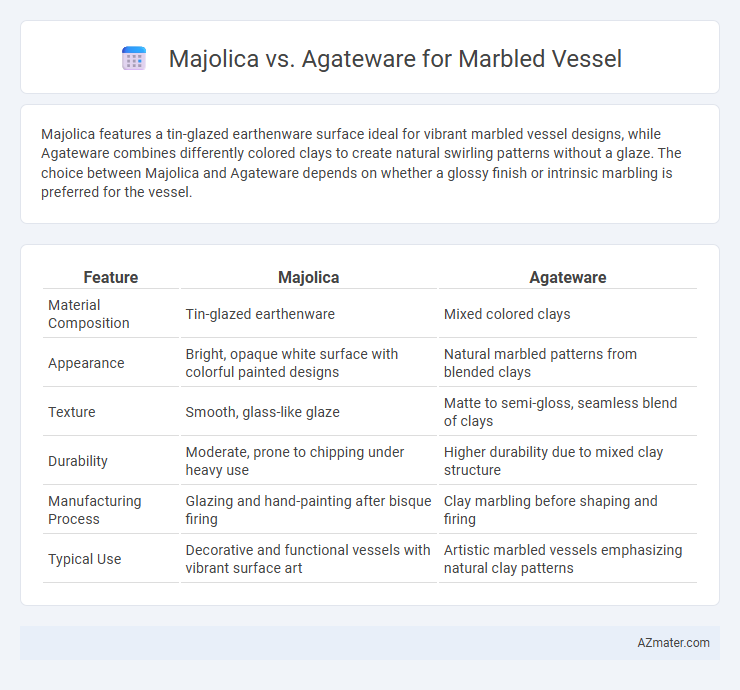Majolica features a tin-glazed earthenware surface ideal for vibrant marbled vessel designs, while Agateware combines differently colored clays to create natural swirling patterns without a glaze. The choice between Majolica and Agateware depends on whether a glossy finish or intrinsic marbling is preferred for the vessel.
Table of Comparison
| Feature | Majolica | Agateware |
|---|---|---|
| Material Composition | Tin-glazed earthenware | Mixed colored clays |
| Appearance | Bright, opaque white surface with colorful painted designs | Natural marbled patterns from blended clays |
| Texture | Smooth, glass-like glaze | Matte to semi-gloss, seamless blend of clays |
| Durability | Moderate, prone to chipping under heavy use | Higher durability due to mixed clay structure |
| Manufacturing Process | Glazing and hand-painting after bisque firing | Clay marbling before shaping and firing |
| Typical Use | Decorative and functional vessels with vibrant surface art | Artistic marbled vessels emphasizing natural clay patterns |
Introduction to Marbled Ceramics: Majolica and Agateware
Marbled ceramics showcase distinctive swirls and patterns achieved by combining different clays and glazes, with Majolica and Agateware as prominent styles. Majolica involves tin-glazed earthenware, creating bright, opaque surfaces often enhanced with colorful painted designs, while Agateware blends contrasting clays to form natural stone-like marbled effects before firing. These techniques highlight unique aesthetic qualities, with Majolica emphasizing vibrant surface decoration and Agateware focusing on the intrinsic beauty of clay patterns.
Historical Origins of Majolica and Agateware
Majolica, originating in the Italian Renaissance during the 15th century, is characterized by its tin-glazed pottery with vibrant, colorful designs that became highly popular across Europe. Agateware, developed in 18th-century England, features a marbled effect achieved by blending different colored clays to mimic precious agate stone, offering a contrasting naturalistic aesthetic. Both techniques showcase distinct historical craftsmanship, with Majolica emphasizing decorative glazing and Agateware focusing on clay manipulation to create marbled vessels.
Defining Characteristics of Majolica
Majolica is defined by its vibrant, tin-glazed surface that offers a bright white, opaque background ideal for intricate, colorful designs. This ceramic style features a glossy finish achieved through a lead-based glaze, which enhances the visual appeal and durability of marbled vessels. Compared to agateware, which combines different colored clays to create natural swirling patterns, majolica emphasizes painted decoration over the clay body's natural tones.
Key Features of Agateware
Agateware is characterized by its distinctive marbled appearance achieved by combining differently colored clays, offering unique organic patterns and a tactile texture rarely found in pottery. Unlike Majolica, which is known for its vibrant colored glazes on a white tin-glazed surface, Agateware emphasizes natural clay colors and intricate swirling designs that highlight the craftsmanship of clay mixing techniques. Its durability and muted aesthetic make Agateware ideal for marbled vessels intended to showcase subtle elegance and artisanal detail.
Marbling Techniques: Surface Decoration vs. Clay Mixing
Majolica marbling techniques emphasize surface decoration by applying colorful glazes on a white, tin-glazed ceramic body to create intricate, vibrant patterns. In contrast, Agateware employs clay mixing, blending differently colored clays together before shaping to produce natural, swirling marbled effects throughout the vessel's structure. This key difference impacts both the visual depth and tactile texture of marbled vessels, with Majolica offering surface brilliance and Agateware showcasing integrated marbling within the ceramic body.
Material Composition and Glazing Methods
Majolica features a porous earthenware body coated with a tin-based opaque white glaze, which serves as an ideal canvas for vibrant, detailed painted designs using metal oxide pigments. Agateware combines different colored clays--typically white and brown or buff--through a marbling technique that creates a natural, stone-like appearance without the need for painted decoration. The glazing method for Majolica involves a glossy, lead-based glaze that enhances color brilliance, whereas Agateware typically uses a transparent or lightly tinted glaze to preserve the tactile and visual texture of the marbled clay body.
Aesthetic Differences: Colors and Patterns
Majolica ceramics showcase vibrant, opaque glazes with bold, multicolored patterns that emphasize bright blues, greens, and yellows, creating a lively and glossy appearance for marbled vessels. Agateware, in contrast, features subtle, earth-toned swirls in natural clay shades like beige, brown, and gray, offering a more muted and organic marbled effect with matte or satin finishes. The aesthetic difference lies in Majolica's vivid color palette and glossy texture versus Agateware's understated, natural hues and softer visual appeal.
Functional Properties and Durability
Majolica offers a vibrant, glazed surface that is highly resistant to staining and easy to clean, making it ideal for decorative marbled vessels with functional utility. Agateware, characterized by its mixed clay bodies without glaze, provides greater durability against chips and cracks due to its denser, fired clay structure. For marbled vessels intended for daily use, agateware ensures better impact resistance, while majolica excels in moisture resistance and aesthetic appeal.
Artistic Applications: Choosing the Right Technique
Majolica offers vibrant, glossy finishes ideal for detailed, colorful marbled vessels, enhancing intricate painted patterns with its smooth, glass-like surface. Agateware, characterized by its layered clays in natural earth tones, creates organic marbling effects perfect for earthy, textured artistic expressions and sculptural forms. Selecting between Majolica and Agateware depends on the desired visual impact: Majolica for bright, polished aesthetics and Agateware for subtle, tactile depth in marbled ceramic art.
Conclusion: Selecting Majolica or Agateware for Marbled Vessels
Majolica offers vibrant, opaque glazes that enhance the intricate marbled patterns, making it ideal for decorative vessels requiring rich color depth. Agateware features naturally blended clays that create organic, multi-tonal marbling with a subtly textured surface, perfect for functional pieces emphasizing artisanal craftsmanship. Choosing between Majolica and Agateware depends on prioritizing either vivid glaze impact or natural clay aesthetics for the marbled vessel's intended visual and tactile experience.

Infographic: Majolica vs Agateware for Marbled Vessel
 azmater.com
azmater.com